Southend United
Football had been played in Southend for some time before the modern club was founded. Indeed a team known as Southend United is recorded as early as 1898-97 but they have no connection with the present club. It was not until 1906 that the landlord of the Blue Boar Hotel, Oliver Trigg, met with fellow enthusiasts to form a new professional football club to take the place of Southend Athletic, which had just gone out of business. Southend United were immediately admitted to the Second Division of the Southern League, winningpromotion to the First Division in 1908. During the Great War United's ground at Roots Hall Fields was turned into allotments and United moved to a new ground next door to the Kursaal Pleasure Park in 1919. Photographs show the stadium dwarfed by a giant water-chute, one of the principle attractions of the seaside resort at that time.
In 1920, Southend became founder members of Division Three when the old Southern League Division One was incorporated into the Football League. They remained at this level until 1958 when the regional divisions were scrapped and "The Shrimpers", as they were called, were placed in Division Three.
The club left the Kursaal in 1934 to move to a greyhound stadium at Grainger Road before returning to their original Roots Hall home in 1955. The ground was built from scratch over two years with funds raised entirely 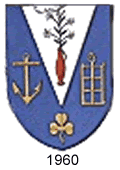 by the Supporters' Club. Over the years the club became associated with mud - whether because of the state of their pitch or the endless vistas of the Thames estuary at low-tide is unclear.
by the Supporters' Club. Over the years the club became associated with mud - whether because of the state of their pitch or the endless vistas of the Thames estuary at low-tide is unclear.
Southend's traditional colour has always been blue, although the shade has varied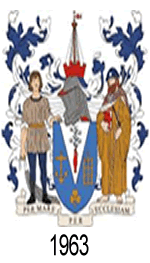 considerably over the years, but between 1959 and 1961 white shirts were adopted. These included a crest in 1960-61 that appears to have been based on the central badge of the town's coat of arms. The full coat of arms was worn for a couple of seasons in the middle of the decade.
considerably over the years, but between 1959 and 1961 white shirts were adopted. These included a crest in 1960-61 that appears to have been based on the central badge of the town's coat of arms. The full coat of arms was worn for a couple of seasons in the middle of the decade.
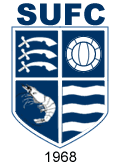 In 1968 Southend adopt all-navy shirts on which the coat of arms were replaced by a crest designed specifically for the club. Part way through the season the club was instructed to
In 1968 Southend adopt all-navy shirts on which the coat of arms were replaced by a crest designed specifically for the club. Part way through the season the club was instructed to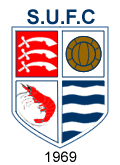 change because the navy tops were too similar to the black shirts worn by referees: after the team played in shirts borrowed from various clubs, the supporters chose West Brom's stripes which were adopted for the rest of the 1968-69 season and the one that followed. The crest worn on these tops was rendered in colour.
change because the navy tops were too similar to the black shirts worn by referees: after the team played in shirts borrowed from various clubs, the supporters chose West Brom's stripes which were adopted for the rest of the 1968-69 season and the one that followed. The crest worn on these tops was rendered in colour.
In 1968 United were relegated to the Fourth Division and that's where they stayed until 1972 when the team began a yo-yo career that brought four promotions and as many relegations over the next 18 years.
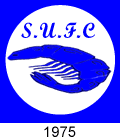 A horizontal monogramme was adopted in 1970 to be followed by one of the more oddball badges that appeared in the Seventies. This was a shrimp, originally embroidered in white against the plain blue shirts with no further embellishment. In its
A horizontal monogramme was adopted in 1970 to be followed by one of the more oddball badges that appeared in the Seventies. This was a shrimp, originally embroidered in white against the plain blue shirts with no further embellishment. In its 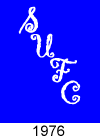 final season, however, the shrimp turned blue and was embroidered onto a white circular patch with the club initials.
final season, however, the shrimp turned blue and was embroidered onto a white circular patch with the club initials.
Red trim was introduced in 1975 and remained in favour for the next decade. The shrimp was replaced by a more conventional diagonal monogramme typical of the period.
 From 1980 the team sported a very new look with white shirts set off by blue raglan sleeves and worn with plain blue shorts and socks.
From 1980 the team sported a very new look with white shirts set off by blue raglan sleeves and worn with plain blue shorts and socks. 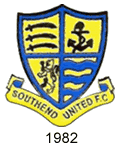 Another novel badge was adopted, which looked like rather third-rate and which, oddly, was worn on the right-hand side of the shirt. This was replaced after two seasons by an altogether more traditional design that remained in favour for the next 18 seasons.
Another novel badge was adopted, which looked like rather third-rate and which, oddly, was worn on the right-hand side of the shirt. This was replaced after two seasons by an altogether more traditional design that remained in favour for the next 18 seasons.
In 1985, yellow replaced white. In 1990, having been relegated the season before, United were promoted in third place, having led the Fourth Division table for most of the campaign. The following season, against all expectations, United were promoted again in 1991. For six splendid seasons, the Shrimpers played in Division Two/Endsleigh League Division One, even sampling European football with a tie against Fiorentina in the Anglo-Italian Cup.
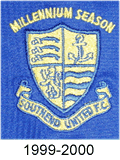 In 1997 the bubble burst and Southend were relegated to Nationwide Division Two and then immediately to the Nationwide Third Division, the lowest tier of the Football League.
In 1997 the bubble burst and Southend were relegated to Nationwide Division Two and then immediately to the Nationwide Third Division, the lowest tier of the Football League.
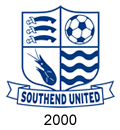 The turn of the millennium brought a new crest. Broadly similar to its predecessor, a football replaced the anchor in the top quarter while the shrimp made a welcome return on the lower quarter.
The turn of the millennium brought a new crest. Broadly similar to its predecessor, a football replaced the anchor in the top quarter while the shrimp made a welcome return on the lower quarter.
The navy and white theme was revived in 2001 when regulations were more liberal and income from the sale of replica strips drove clubs to redesign their kits on a regular basis. A dramatic revival began with promotion in 2005 followed by the League One title in 2006, taking the Shrimpers back to the second tier, or the Championship as it had become known.
In November 2009 Southend avoided being placed into administration after agreeing to pay £2,135,000 in unpaid taxes to HM Revenue & Customs. The club had originally faced a winding up petition over a tax bill of £690,000 but HMRC applied to have to club put into administration as the debt spiraled. The dispute dragged on with a transfer embargo imposed by the Football League until a final settlement was reached with HMRC on 2 August 2010.
